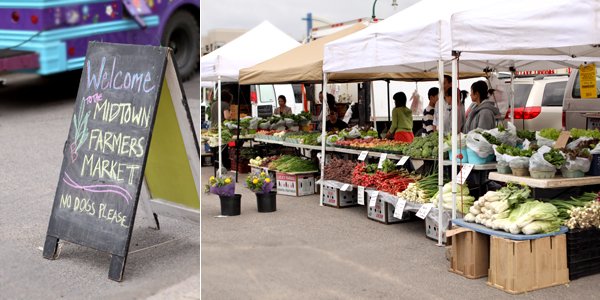
From a perch on the steps of the Anishinabe Academy building, one may catch glimpses of the past, present, and future of this tiny, clamorous patch of Minneapolis. The name of the elementary school that establishes the borders of the farmers market is an Ojibwe word, meaning something along the line of “First People.” The people on the street, whose faces are (more often than not) a few shades darker than Sven and Ole’s, prove Lake Street’s continuing role as a magnet for immigrants.
And then there’s the Midtown Farmers Market, which is going to play a key role in the neighborhood’s future. As noted on the Churn last week, the proposed development plan for the neighborhood cites the market as a “keystone element” for shaping the community’s identity. It is so important that the impending loss of the market’s current space has prompted community planners to create a space outright for it in their proposal.
At the moment, the market is a little bit rag-tag, but has tons of character to make up for it. As one overhears the modest befuddlement of older gents cradling their first tastes of tamales, one cannot resist the temptation to be charmed. I promise — your cynical, postmodern heart will break in two when you are forced to confront the violent sincerity of PlantWorn‘s asparagus shirts. But if you want to save time with a full-blown nuclear missile of homegrown love, just look for Tootie.
The market is open Saturdays 8am-1pm and Tuesdays 3pm-7pm.
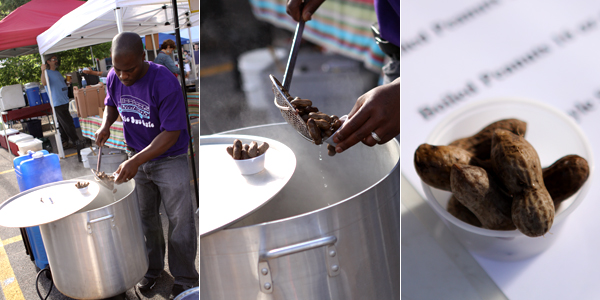
1. Tootie’s Boiled Peanuts ($3 for 8-oz bag)
Sometimes there is nothing more satisfying than being talked at by an extremely enthusiastic person. Tootie Martin will tell you all about boiled peanuts: their history, their cultural significance, and their culinary applications. I’m leaving out the details so you can get Tootie to tell you himself. The peanuts themselves are beautifully tender and salty, just the way Robert E. Lee intended.
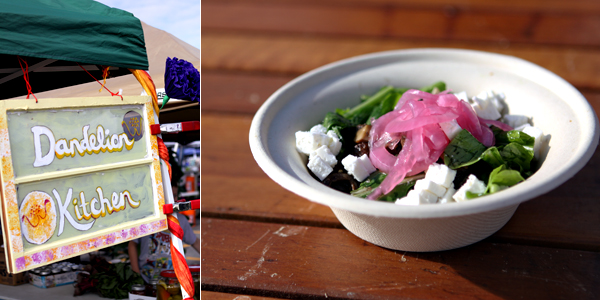
2. Lemon Ginger Soda from Dandelion Kitchen ($2)
While Dandelion Kitchen serves great food, their lemon- and ginger-flavored soda is the perfect cure for hot weather blues. (Miss winter yet?) Made in-house and served from a keg, the soda’s ratio of lemon to ginger to water provides the right amount of tang and spice for maximum relaxation. Until you run out, and the weeping begins.
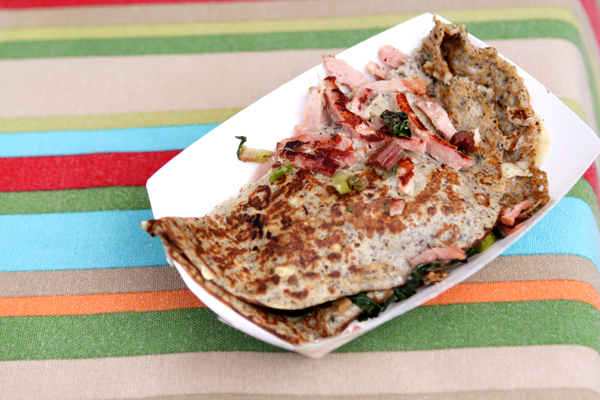
3. The Chef’s Special Crepe from Midtown Market Crepes ($6)
This crepe stand is doing an amazing job of publicizing what’s in season, dropping names left and right with every menu change. Most of their ingredients come from their farmers market comrades, like Gardens of Eagan, Laughing Stalk Farmstead, and Va Vang. Their chef’s special is an excellent way of learning what’s in season to gain some locavore street cred. When we ordered the special last month, it featured rainbow chard, kale, sugar snap peas, green onions, cheese, and local ham. Try this with the buckwheat crepes!

4. Pesto Pizza from Olive Pizza ($7)
Olive is an impressive newcomer to the city’s farmers market scene. With the help of their mobile wood-burning pizza oven, they rock Neapolitan-style pizzas with panache. Veterans of Punch Pizza will be happy to know that Olive can get you from zero to pizza in five minutes flat. (Longer, of course, if there is a line.) The pizza is thankfully not of the soggy-centered variety, which would inhibit the necessary walking-while-eating dynamic at the market. And while the ingredients are solid, it’s the crust that really — literally! — carries the dish.
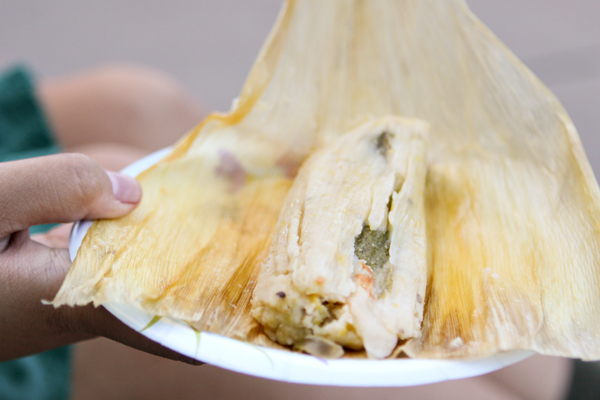
5. Tamales from La Loma at Fireroast Mountain Cafe ($3.25 each)
When you think you have them pegged as a coffee and pastry bunch, Fireroast seems to pull its tamales out of thin air (or, as we find out, La Loma). Unfortunately for latecomers, they’re not a well-kept secret: They tend to run out of them really quickly at lunchtime. If you manage to snag one, really savor it, I would argue that their tamales really give La Loma‘s a run for their money, and the price is certainly right. Though listing off the fillings seems like a moot point (because, really, just get what hasn’t sold out yet), they are: veggie, pork, chicken, mole chicken, and the larger Oaxacan chicken.
Midtown Farmers Market
Lake St E & 22nd Ave S
Minneapolis, MN 55407
Saturdays 8am–1pm May to October
Tuesdays 3pm–7pm June to October

I was JUST wondering where I could find boiled peanuts on a reliable basis here in the Twin Cities. (Quang randomly had some last summer, but usually I’ve had to order them from boiledpeanuts.com!) Thank you so much for sharing this awesome find. Boiled peanuts rock!
“I would argue that their tamales really give La Loma‘s a run for their money”
I would argue that their tamales come from La Loma.
Tom-
Ha! We called up Dave over at Fireroast to confirm, and he belted out in laughter: “we love La Loma!” Sure enough, that’s where they get them. I’ve made the correction on the piece. Thanks.
Aaron Landry
Producer
The Heavy Table
La Loma just catered my birthday party. It rocked. Enough about me.
Boiled peanuts? More like boiled mush.
Nice article. I’m ready to
go, but why would the writer not include the address? Strange.
Justin-
Our writer linked to the official site at the top of the piece, but I completely agree that the address is helpful. Added. Thanks.
Aaron Landry
Producer
The Heavy Table
I would argue that La Loma tamales taste better when they cost more, as in $3.25……..and when eaten outdoors in a very fun farmer’s market. By the way all of their tamales contain lard…just so the ‘vegetarians’ are informed…
I would suggest that a heavy ratio of immediately consumable foods (ICF’s) to growers/producers at farmers markets is detrimental to farmers and growers in my view. The Lyndale Farmers Market I am a Board member of has very few ICF’s per the number of growers and we did not open the door for mobile food buses either for this reason . Folks often have a limited amount of cash to spend and enticing them with snacks and munchies takes money off the table for growers many of which have perishable items that they need to move weekly.
Farmers markets should first and foremost be a place to buy from growers/producers NOT a venue for artists, food vendors or small restaurants.
My opinion is the bulk of ICF selling should be reserved for the grower/producers who have the resources to offer their wares in the form of ICF, like ice cream, roasted corn, soups, sandwiches from their own meat etc.
@Brian, I’ve found that the food trucks often get me to the farmers market in the first place. Once I’ve had a quick snack, I pick up some items for meals at home.
Brian-
You make the mistaken assumption that ALL people who come to a farmer’s market are coming for the same reason. I can buy the very same fruits and vegetables at every farmer’s market running this summer. Those who create a larger experience for me are the ones that get my business. More variety on offer means more, and more varied, customers for all vendors. Limiting your offerings means fewer, and more like-minded, customers, which, I would argue, has a detrimental effect on your vendors.
By increasing the number and diversity of your offerings, and thereby your customers, your vendors with the immediately perishable produce will stand a far greater chance of selling it quickly, than if you merely yell more loudly that you TOO have green beans and peas on offer.
My $.02.
Ed, I think the question is more what the correct ratio is for ICF and farmers, Certainly we want to support local food establishments, but I do see a lot of “creep” in some markets where the emphasis on moving produce and farmstead products is lost in a sea of ICF, crafts, service booths and entertainment.
Food trucks and restaurants have theoretically 365 days a year to sell their products and services. Farmers have a very small window and the value of fresh produce drops significantly with in a short time period. Its a make or break for many growers who need a strong market to unload their crops at a good price.
If the plethora of new markets cannot find enough growers/producers to operate a market without watering it down with these other offerings one must question if a new market is needed at all.
Are there enough farmers and producers to fill what’s becoming an over saturation of farmers markets in the Metro? Do we run the risk of losing the indentity and goal of a farmers market as some morph into a festival like atmosphere?
There are some growing issues not being addressed as neighborhoods and suburbs rush into opening new markets. How often if ever are FULL time growers and producers polled to see how this market growth is working out before congratulating each other for opening another market ?
I’m not directing that last comment at Midtown either, but there are troubling trends on the horizon that threaten to undermine the value of farmers markets as an economically viable venue for growers and producers. I question the need for a Fulton neighborhood Saturday market for instance in 2011.
City Folks who want to help out farmers would be well served to not open another market at this juncture but rather support the existing markets to give time for new growers to emerge and existing markets to become stable sources of farm revenue. In my view, the growth of markets is not keeping pace with the realities of starting a farm related enterprise that relies on skills, savvy and experience that does not come quickly,
Is this truly a problem for anyone other than in some silly religious war “more farmers market than thou” sort of way? Really?
Dave hits it on the head — it’s not like there’s a huge diversity of produce that can or will be grown locally. Yes, maybe I cant get the particular microstrain of heirloom beans I like at every market, but still — beans, tomatoes, corn, potatoes, etc etc etc.
Seems to me there are enough farmers markets in the Cities where some market segmentation (no pun intended) would be a GOOD thing.
To advertise yourself as “the market that only has farmer/producer goods” or as “the market with the greatest diversity” or “the market with the best handicrafts AND food” would set one’s market apart from the others.
Folks like Brian need to focus less on market content and more on marketING. Otherwise, it’s just another grocery store only with really crappy hours.
In the sense that there are still a ton of people that buy the same produce you can find at a farmers market at the grocery store instead, I’d think we’re far from saturated. That’s a behavioral thing, though, and probably a whole ‘nother issue.
I do what Ed does. The “everything else” is often what gets me there in the first place, and then my produce shopping gets done after that. To Dave’s point, I guess it depends on what the market is trying to be. But Brian makes a good point about farmers needing to evaluate if it’s worth their time. I don’t think there’s any one answer. Yeah, Mill City draws a lot of people from all over because of their variety of offerings (and location). But if, say, Tangletown has more produce and less “other” but draws *everyone* in the neighborhood every week, it’s just a different market. I think there’s room for both and I’d rather see experimentation than ideology.
If it makes any difference, the last two times I went to the Midtown Farmers Market was because of Olive Pizza and was then exposed to the other farmers there. The last time I went to the Kingfield Market was because of Chef Shack and came home with local produce and honey. I’ve never had a reason to go to trek to the Lyndale Farmers Market, although I should probably check it out sometime soon. I lived across the street from the Saint Paul Farmers’ Market for two years and actually sought out breakfast snacks before I brought home fresh food for cooking later.
And where does the ideology end?
I go to Mill City Market for just one thing — flour from Sunrise Mills (seriously — great flour for sourdough). But they don’t raise the wheat, they just mill it. Would they producers? Or is the flour a value-added product? Or would they be like the guys who sell bananas — just another vendor selling something else they didn’t raise?
Many vendors I talk to who have done markets for 10 years of more agree that market share is dwindling and we find ourselves selling at more markets to get the same share of revenue as we did even 5-7 years ago. Newer growers who arrived on the scene in the last 1-5 years would not see this trend. Going to more markets means more expenses, rent, fuel, labor etc.
I rarely if ever see the concept of economic sustainability surrounding the farmers market scene discussed or even acknowledged and thats my main point to get some discussion going. Its always great news another market is opening – but great news for whom, the consumers? Doing a farmer market takes an incredible amount of time and in the scope of selling produce its not very efficient unless you’re hitting some good sales numbers. Seasoned growers I know would like to see less markets and more central larger markets that have the capacity to provide a stable source of income.
Can you imagine trying to pay your mortgage based on farmers market sales? The weather, crowds and yes competition from other markets all play into the ability for a grower to make it fly and its not easy. Newer markets can be a crap shoot really.
The issue of ICF has been around forever at local markets, while we have a long history of resellers at Lyndale that some people find troubling the NON-ANNEX side of the market has a very LOW ratio of ICF to grower/producers. I’ve never suggested that no ICF should be allowed but I favor the idea that priority be given to the growers/producers who have the resources to do it.
Each market sets there own rules and must struggle to find the right priority and that is what shapes each market and gives it an identity. The Processors category is growing possibly faster then the grower/producer and each one is an individual story in of itself that a market might consider.
As far as the banana sellers go in the 1970’s the Lyndale market almost closed due to a loss of interest and the CITY OF MPLS decided to let in resellers to “save” the market. 35 years later these same vendors are there and I’m not sure its fair to toss them out. There is a moratorium on resellers and attrition has reduced the number over time.
My point I wanted to make is there are many concerns on the grower/producer side that may not be considered. A part time weekend warrior grower who has been around for 1 or 2 years has a much different viewpoint then a full time grower trying to feed a family or make payroll.
My concern is are we headed for similar problems as seen in CA which tends to lead the country in food trends?
http://online.wsj.com/article/SB10001424052748704533204575048000839268376.html
http://articles.latimes.com/2007/apr/11/food/fo-farmers11
I don’t claim to have all the answers as the economy and interest in local food is very dynamic and changing, but I would like to see this issue on the radar and acknowledged, which I don’t feel is the case right now in the Cities. What is the right mix at a market and how many markets is in the best interests of the growers/producers?
I’m tired of people who make me feel guilty because I am not eating the right food from the right producer who might not be able to make a mortgage payment. I don’t care about ICFs whatever they are. I spend many $ at many different farmers markets and I think it’s weird that now there is a political issue about food being sold at my LFM (local farmers market). Has food become so political that it requires a lecture everytime we eat/buy it? I try to do my part in the whole local food thing but some of this stuff just makes me want to crawl in a hole and never eat again. In other words, it is somach turning.
I do not care to visit Midtown again!
1) To Small.
2) Most of the time I miss it was even going on, Mabe you should move the tents closer to the fence line facing lake street.
3) The midtown staff has been so PICKY choosing WHICH venders can come in they missed the OPPORTUNITY given them.
4) Change the name, Mabe “Midtown festival” and Local Farmers Market.
For now I drive right by “Not Seeing” and head down to Lyndale on Saturdays for the Festival / Farmers market going on!
Kelly
p.s. I.M.O. Midtown & Midtown MANAGMENT has failed the neighborhood.